Most Svalbard activities require the company of a guide with a rifle. To protect people and wildlife, outside the town of Longyearbyen it is mandatory to be able to scare off or kill a polar bear, in case you encounter one. Polar bear attacks are rare, but always a possibility.
There are still things you can do on your own and for free. My favorite among them is a walk along the sea in Longyearbyen. This may not sound too exciting, but you get great views of a constantly changing scenery. And because this is the Arctic, a walk on the beach here is different from wherever else you come from.
Many warnings about polar bears can make you feel vulnerable, even uncomfortable. There’s no need for that. You’ll be fine as long as you don’t walk out on an ice floe and find yourself floating away.
The population of Longyearbyen is an active one. Unless there’s a storm, people will be out hiking, skiing, dog-sledding, or even paragliding. If a polar bear is spotted near Longyearbyen, the authorities will immediately be notified. They will handle the situation, including finding and getting people like you out of harm’s way. You are highly unlikely to be the first person to spot an incoming polar bear.
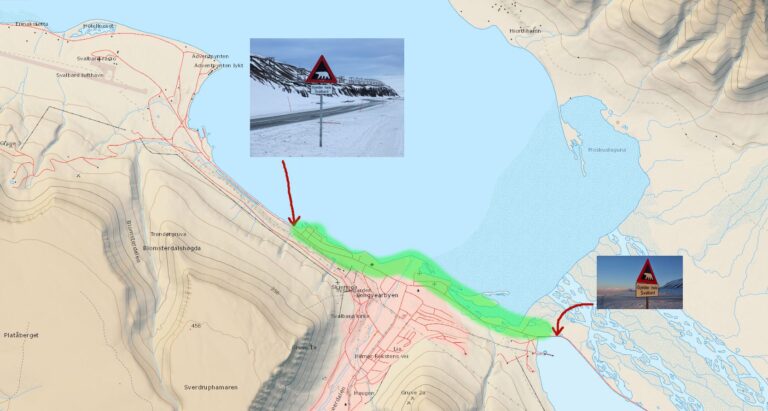
The stretch of coastline that you legally can explore on your own and unarmed is about three kilometres long. Each end of the safe area is marked with a polar bear warning sign. Between those signs, the only thing with a trigger you must carry is your camera.
It’s always best to walk together with someone, although technically even that is not required.
Wearing crampons is never a bad idea. Statistically the risk of slipping on some ice and fracturing a bone is much higher than that of being mauled by a polar bear.
Arguably, this walk is best done in April, when it’s still a winter wonderland and you can enjoy the extremely long-lasting “golden hours”. After 19 April the sun stays above the horizon until late in August. This whole period has plenty of lovely sunset colors. The midnight sun walks are the best. Unless there’s a blizzard, which isn’t that rare, to be honest. Plan on staying in Longyearbyen for a few days to increase your chances for a nice walk.
In this post we start our walk at the western end and move eastwards.
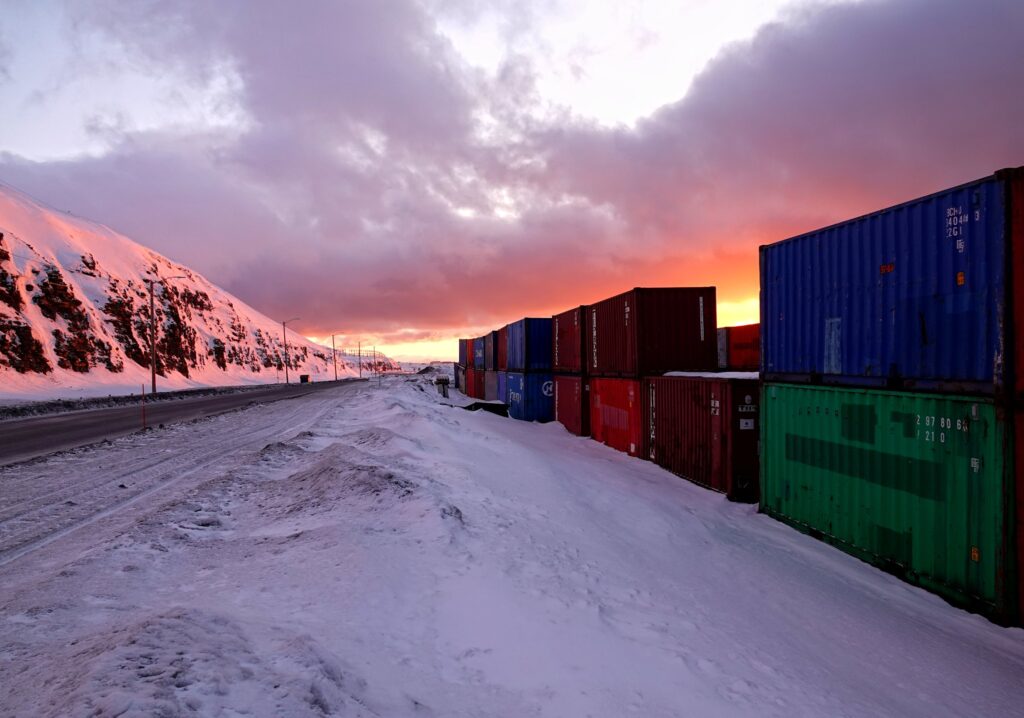
The easiest way to get started on your walk is to simply follow the main road towards the airport. You will pass the university, a shiny metal polar bear, the petrol station, a Thai massage place, the power plant, and the brewery.
Keep going until you see the sign warning of polar bears, just beyond some shipping containers on the right side of the road. If you start at the supermarket in town, it should take you about 20 minutes to get there.
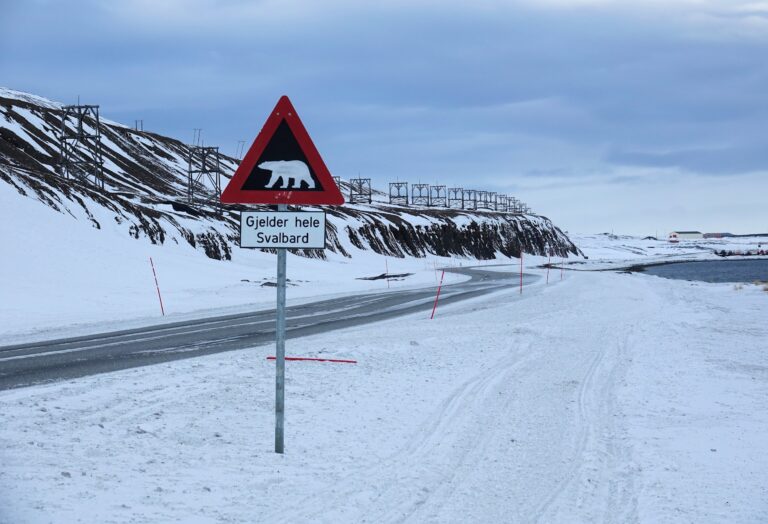
It’s not embarrassing to take a selfie with the polar bear sign.
Then, if you have robust footwear and the tide allows it, head down to the beach.

This quiet little bay is a favorite of birdspotters. Numerous species of seabirds can turn up here, especially late in the day.
The most colorful species you can hope to see is the king eider. They usually arrive around mid-April, to spend the next weeks performing their amusing and highly audible courtship rituals right here.
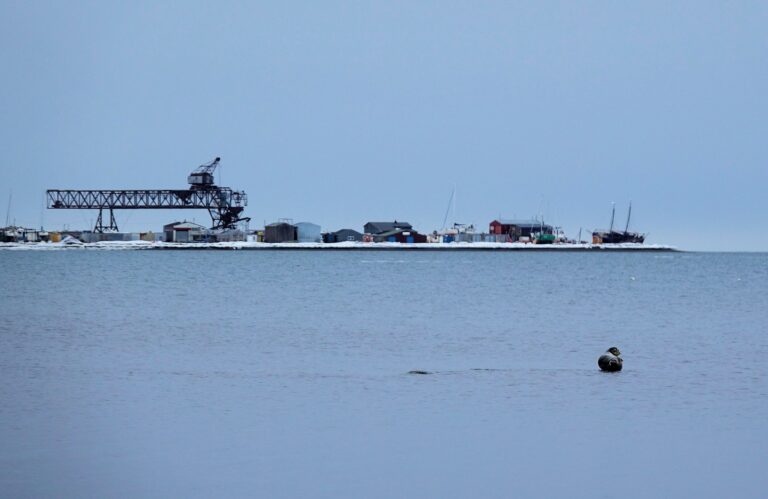
If birding isn’t your thing, keep an eye out for seals chilling on the beach, or if you’re lucky, even a walrus.
From this beach and the cruise port next to it, you can look west towards the airport and the open waters of Isfjord.
Running parallel to the road leading out of town is a long row of old wooden towers. They were used for cable-cart coal transportation. The coal was, and for a short while longer still is, exported from the port in front of the airport buildings. Notice the giant Titan crane, a coal loading mechanism that hasn’t been used since 1979.
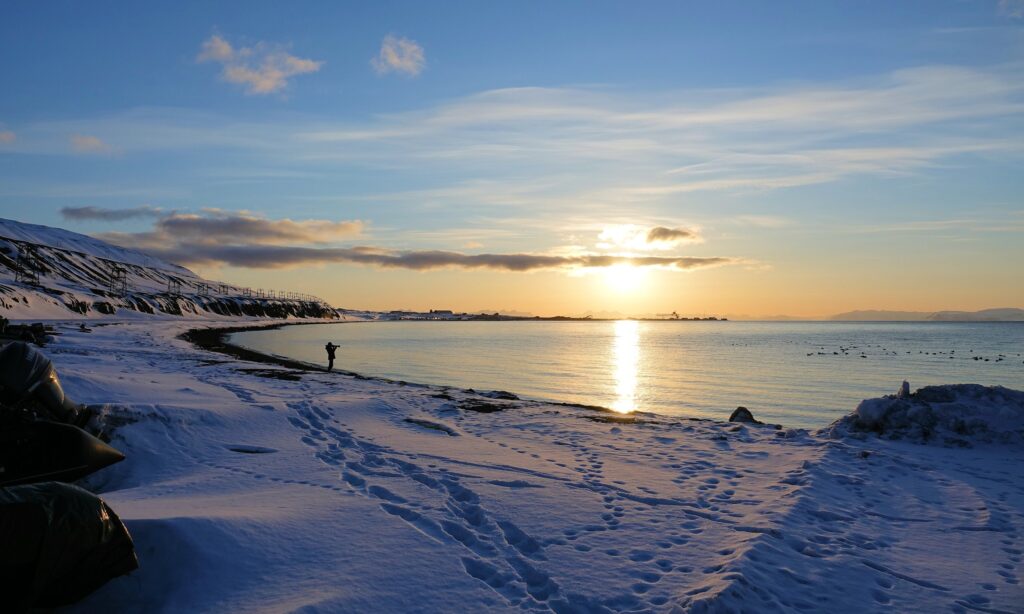
Don’t worry. It’s normal to be entirely captivated by the view from here.
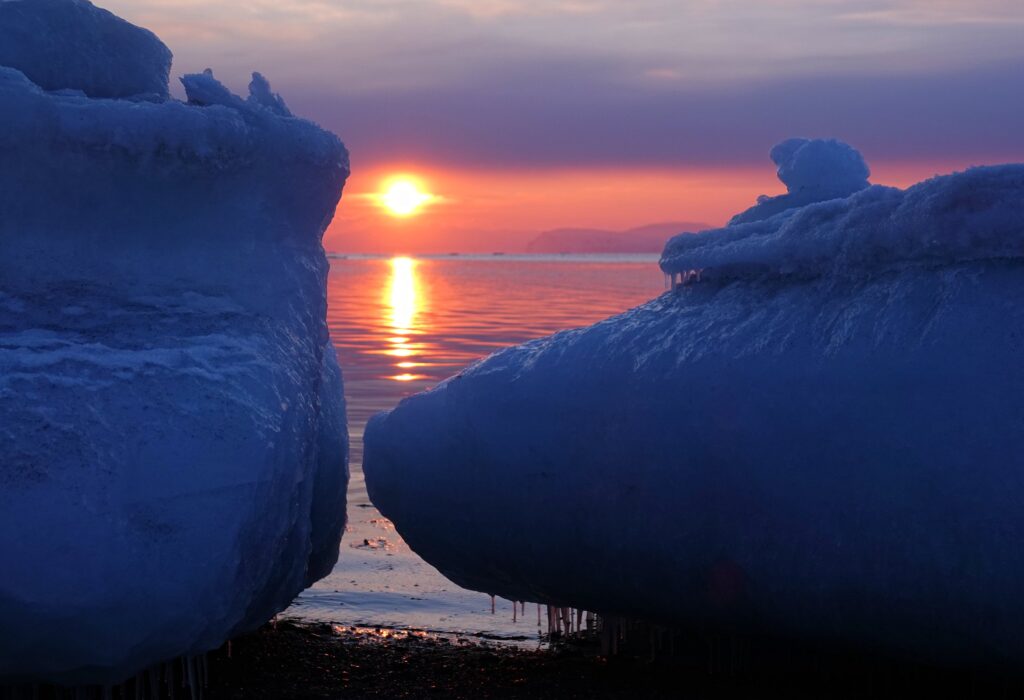
In April you can stay out in the fresh air and enjoy the view for as long as you want.
Darkness simply never arrives, so you will be able to find your way back to your accommodation no matter how late it gets.

As you walk back towards town, follow the waterfront instead of backtracking on the road you came on. Except for a few clearly fenced-off areas, you are free to walk anywhere.
The first thing you see when you head east is the cruise port. It’s nothing to look at, but try to imagine what it must be like in Longyearbyen when cruise ships dock here, carrying enough passengers to temporarily triple the number of people in town. It’s pure madness.
Treasure the peace and tranquility you experience right now.
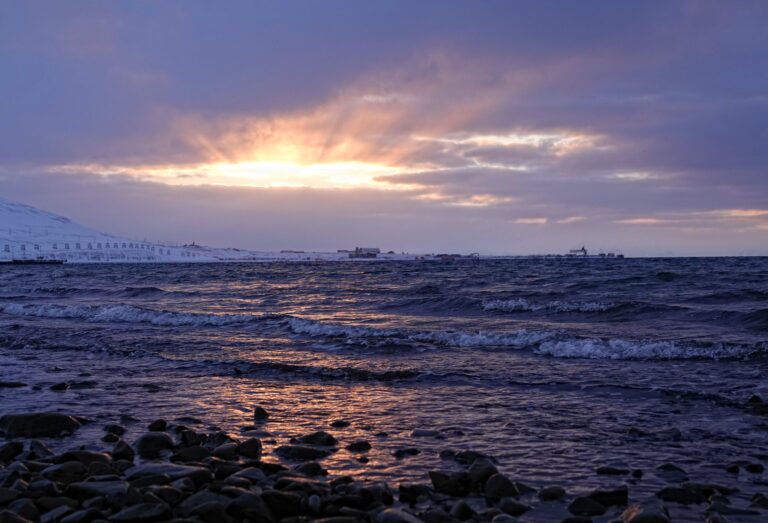
The scenery is not necessarily peaceful just because there are few people around. Longyearbyen and the fjord can get quite windy, although a stormy day in April can often quiet down into a calm evening.
If you are treated to the windy version, embrace it. A good storm can be fascinating, too. Just don’t walk too close to the water if you feel that the wind is strong enough to take you for a ride.

If you are extremely lucky, there is no wind at all. Those times are pure magic.
Even if it’s minus 20 degrees Celsius, a windless night can feel nice and warm as long as you wear the right garments. With wind, the same temperature can make you feel like you are surrounded by small, invisible monsters that bite your skin.
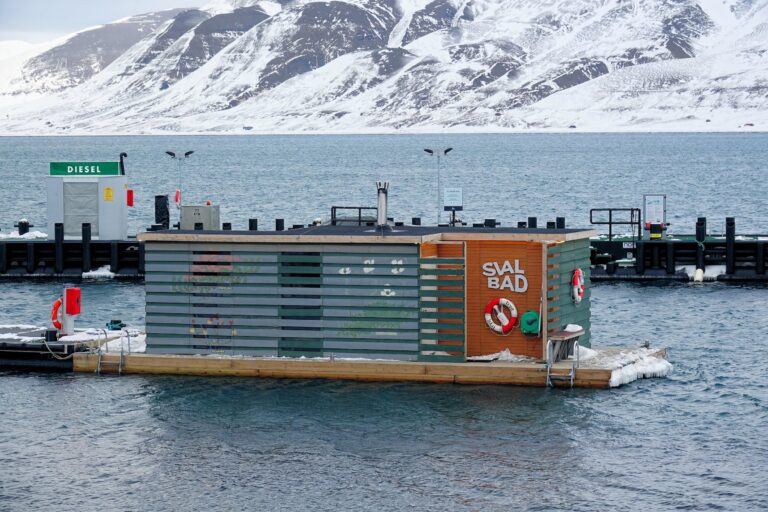
Whether it’s windy or not, do not be surprised if you see someone going for a cold dip in the sea.
Svalbad, a floating sauna in Longyearbyen, is a pun on the archipelago’s name. It means “cold bath”, while “Svalbard” is old Norse for “cold coast”. Both names are fitting.
If you see smoke rising up from the chimney of the sauna, ice bathers are probably nearby. The sauna is fired up on request whenever someone is willing to pay about USD 200 per hour for this experience. That’s not per person, so put together a group to make this an affordable option. After a few swim strokes and hopefully no other stroke, getting back inside a warm sauna is worth whatever it costs.
Do you wonder why firewood is expensive here? The answer; becaut the nearest forest is an ocean away.
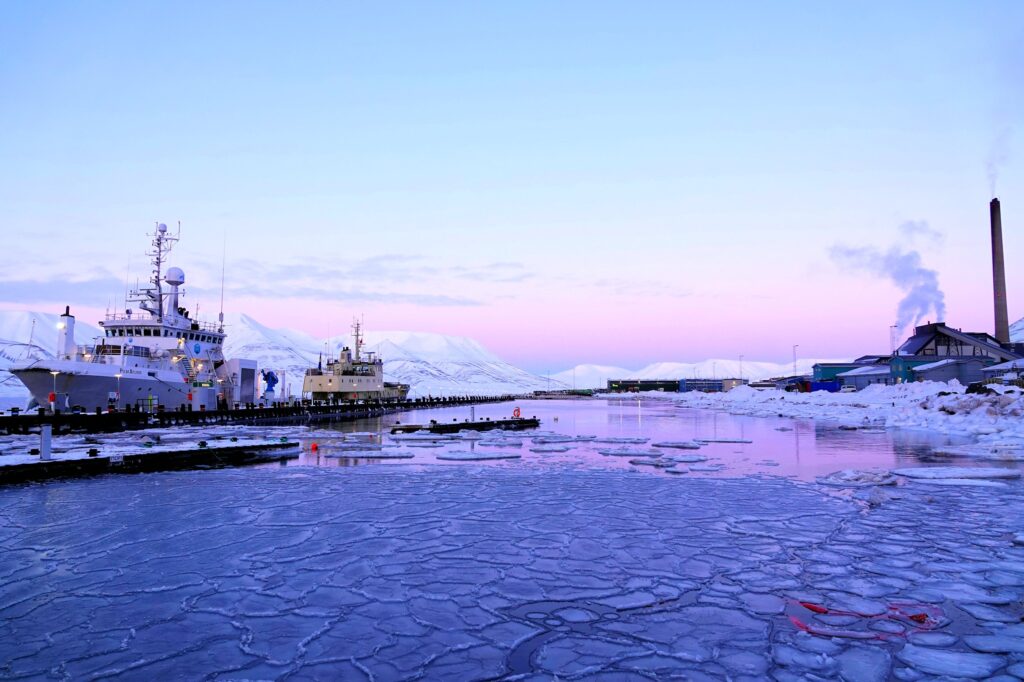
Our next sight is the guest pier, where all kinds of interesting and sometimes surprising vessels visit throughout the year.
Expect to see anything from sailboats that would look more at home in the Caribbean, to ships that clearly are optimized for doing science deep in the Arctic sea ice. Some of these boats take tourists, offering an excellent way for you to increase your chance of a safe polar bear encounter. Trips usually start happening sometime in April, but it all depends on the sea ice conditions.
If you’re here after a good storm and during a particularly cold period, you may see the bay fill up with pancake ice. It is far too salty to digest, but it’s an interesting and somewhat rare thing to behold.
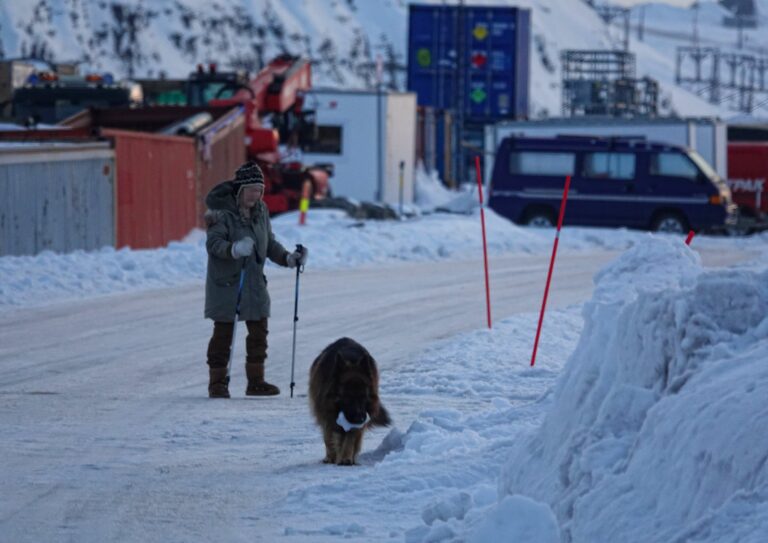
If you see anyone else out walking, don’t be afraid to strike up a conversation. People in Longyearbyen are generally open and friendly, and happy to assist if you have any questions. Some have lived here most of their life, others just come here to work for a year or two before returning to the real world. They all have stories to tell. And often a dog.
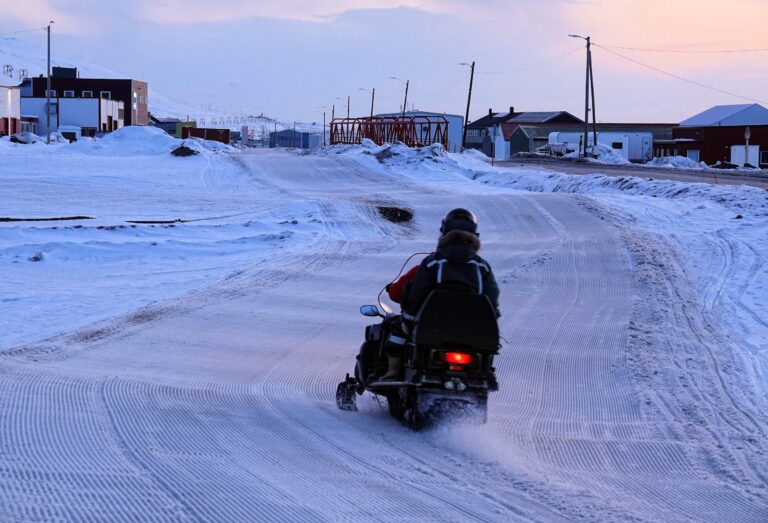
Next to the road, you will often see prepared tracks for snowmobiles. You can walk there, but stay out of the way of the riders. The speed limit in town for snowmobiles is merely 30 kilometers per hour. So you are unlikely to be hit, but you should not consider that a challenge.

It’s impossible to miss this large building with a tall chimney, about midway through your walk. It’s the coal plant, which used to provide the town with electricity. In the fall of 2023, Longyearbyen switched from coal to diesel. It’s theoretically somewhat cleaner, but with coal being available from the mountain next door, while the diesel must be shipped in from the Middle East, it feels a bit nonsensical.
Anyway, it’s an out of use coal plant. Next to the large coal plant is a smaller and older coal plant, barely visible with green walls to the left. It’s full of asbestos, so demolishing it would be a major health hazard. The solution was simple; declare the whole building a cultural heritage site, which therefore must stay in place untouched.
The mountain behind the buildings is Platåberget, Table Mountain. It’s another great hike on almost any day, but you can not go more than about a third of the way up there unless you are in armed company. Lots of locals do the walk, so you can always try asking someone carrying a gun and apparently going that way if they will let you tag along.
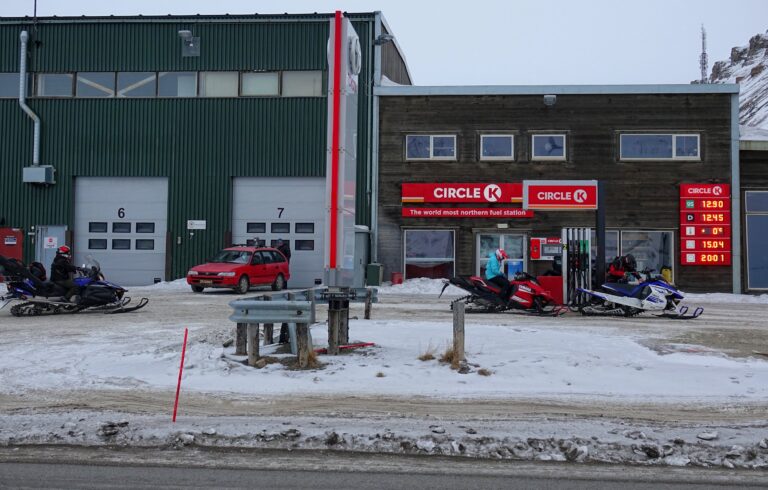
Almost everything in Longyearbyen is the world’s most northern of its kind, including the town’s petrol station.
During winter most of the customers here come by snowmobile rather than by car. The fuel price is significantly lower than on the Norwegian mainland, thanks to the almost complete lack of taxes applied to anything on Svalbard.
While a life without taxes may sound attractive, this is no utopia. Because so little tax is collected from citizens and visitors, only a limited range of services is provided by the government. Especially when compared to anywhere else in Norway. If you have special needs that you can not pay for yourself, or if you are terminally ill, or if you lack income or a place to live, you will be swiftly escorted off the island.
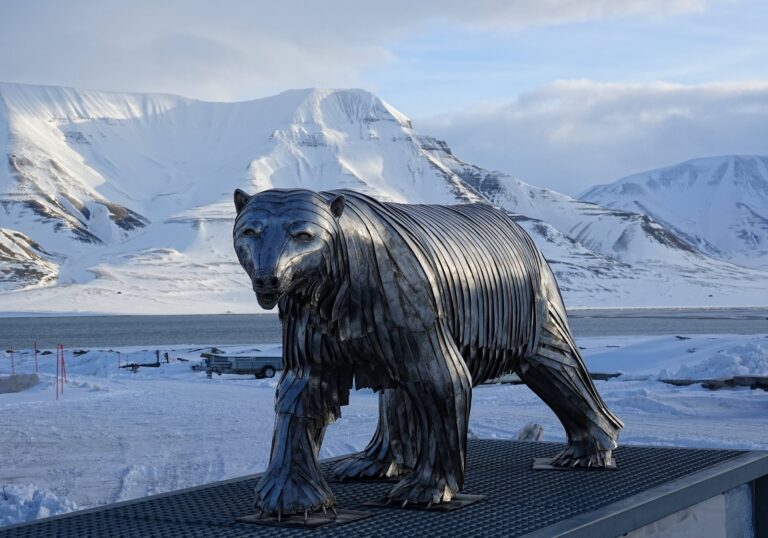
Just past and opposite the fuel station, you are guaranteed to see this particular polar bear. It marks the location of the offices of the company PolarX, a local fixer for every film team coming to Svalbard for some Arctic scenes.
Yes, you can climb it, but be aware that an average down jacket may not survive the encounter with welded steel of the kind used to make this full metal polar bear.

Many kinds of people come to Svalbard to live out their Arctic dreams and fantasies.
Often they have spent years preparing for this. Some of them go out on week-long expeditions, skiing across the archipelago or kayaking around it. Others will just set up their camera somewhere in Longyearbyen and make sure their followers on Instagram get their daily dose of illusions.
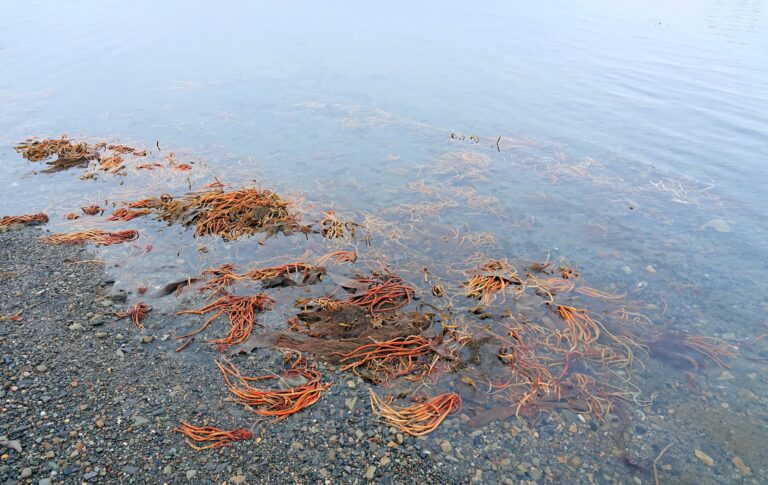
To fully enjoy this walk, you must look beyond merely the mountains and the sky. Much of the beauty of Svalbard is hidden in the details. And sometimes the fascination lies not in what things look like, but in that they are here at all.
Take this brightly colored seaweed, for example. It seems like it’s growing in abundance every year. When ice comes and goes, it is difficult for seaweed to stay in place and grow. As the amount of ice decreases, however, the seaweed manages to establish itself.
In the long run, seaweed and kelp like this can help the animals of Svalbard transition into a new era. Reindeer currently more than they used to now when they search for food. Winter rain occurs more frequently than it used to. Rain in cold weather will quickly cover the ground with a thick layer of ice. Reindeer are well equipped for digging grass and moss out of snow, but not out of ice.
More and more often, reindeer is seen going down to the beach to feed on seaweed. It’s probably not their favorite food, but it’s much better than eating nothing. Global warming may eventually turn Svalbard into a greener place with better food options, but for now the beach food is a welcome extra source of nutrition for the reindeer.
With the sea ice disappearing, polar bears also have an increasingly tougher time hunting seals. The solution for them may be to move over to a diet based on reindeer. Which in turn indirectly may make polar bears depend on seaweed. So when you see this on the beach, remember that it may actually be the key to the survival of the polar bear as a species.
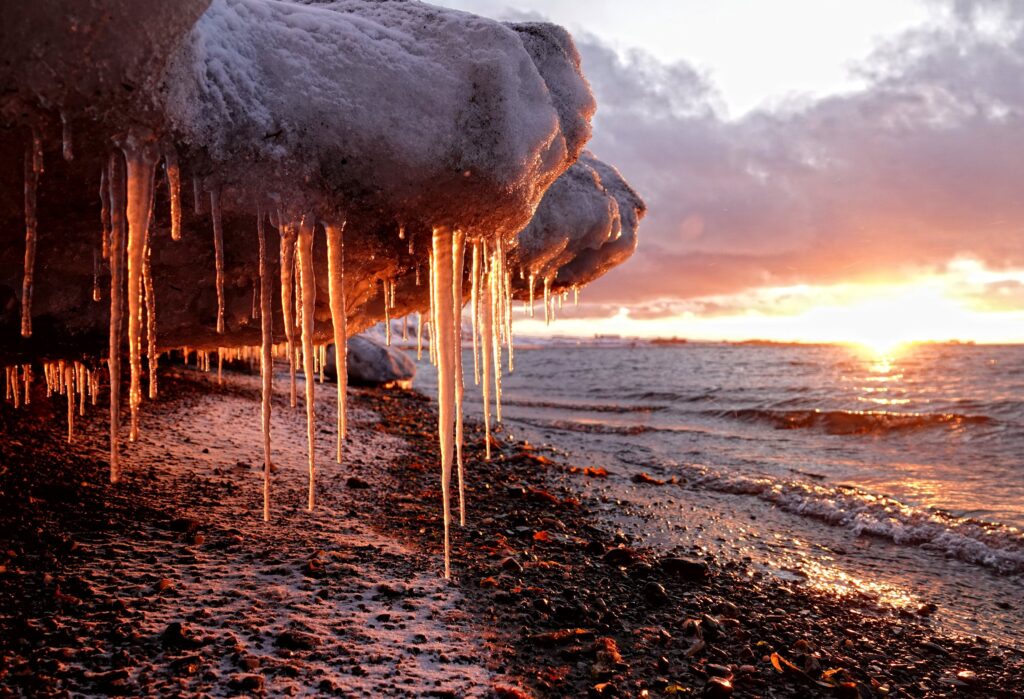
Ice is more than just a life-saver, and also the main sight on this walk along the sea. Fortunately, it doesn’t mean it’s boring. Ice comes in a wide range of shapes and colors.
Sometimes, with the sun low in the sky, it looks nice and warm. Although it isn’t.
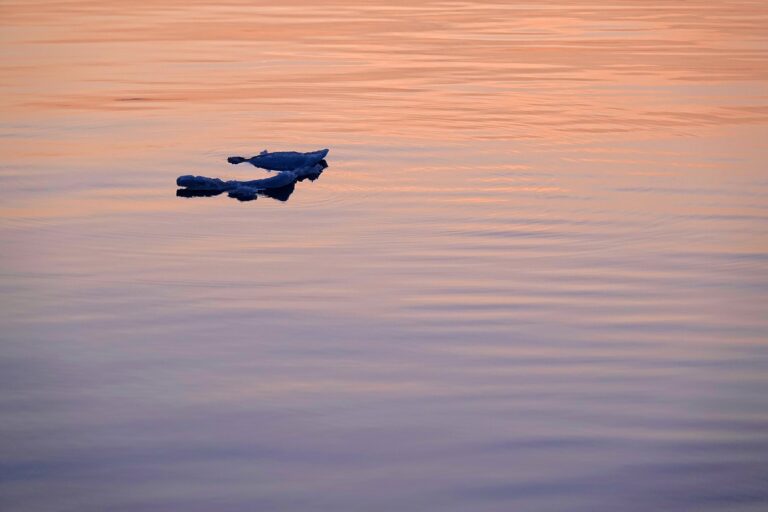
Sometimes you catch a mysterious ripple in the water, which could be anything, really.
Most often it is ice.
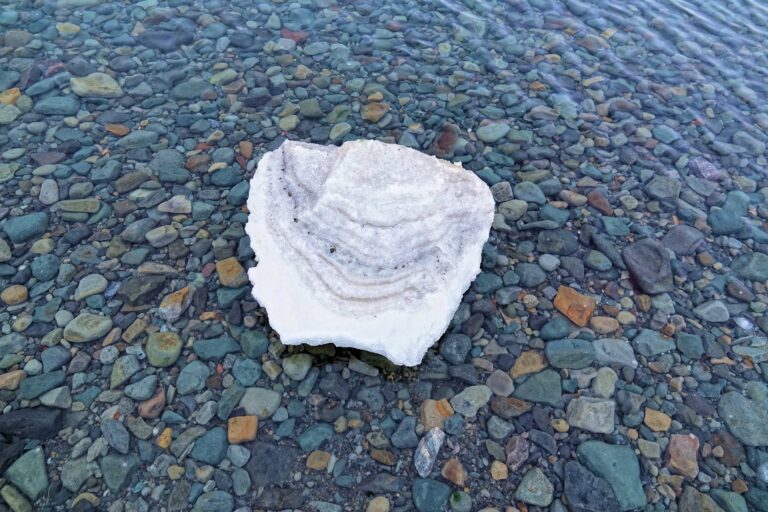
Sometimes it gets stuck in shallow water, melting literally at a glacial pace, revealing new patterns as it transforms into water.
Also, check out the incredible diversity of stones on this beach. A thousand glaciers have crushed and brought together rocks from many different mountains and lands, and the sea has expertly polished them. Svalbard even has lots of fossils. This land used to be a tropical island, home to countless lifeforms, before it spent millions of years traveling north, bringing its geological baggage along.
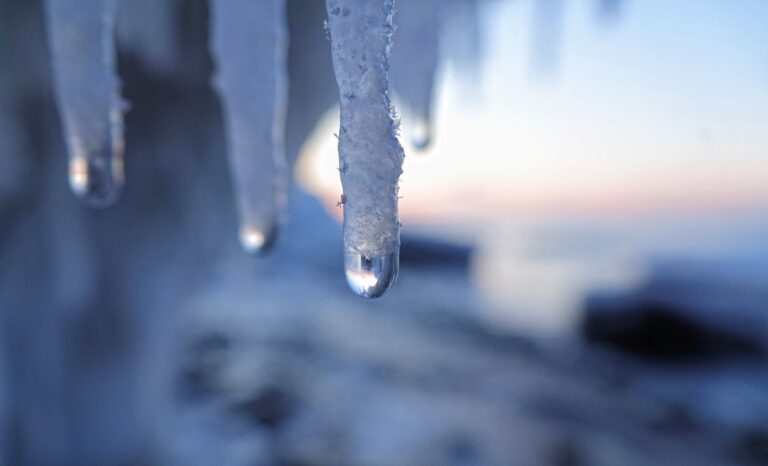
Sometimes you have to look really close at it to catch how wonderfully complex ice can be.
Especially when it’s ice made from sea water. This kind of ice plays by a different set of rules.
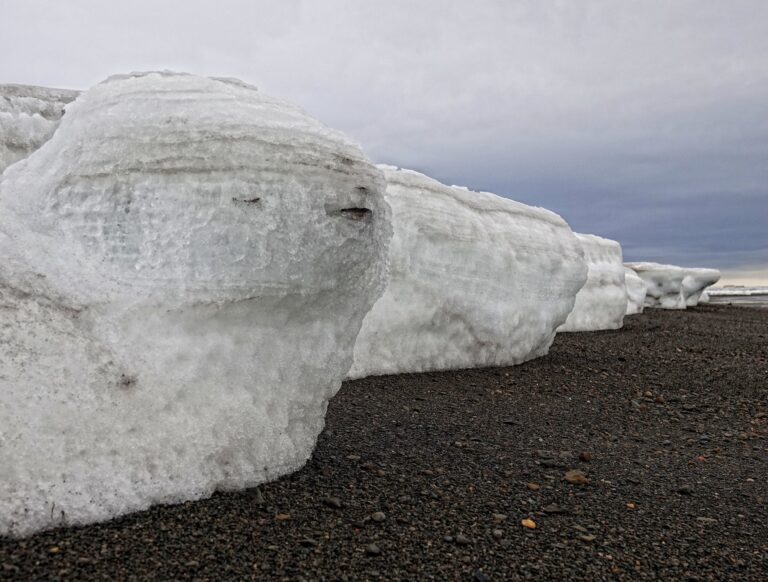
The white cliffs of Longyearbyen appear each time the sea retreats, leaving behind the wall of ice that the water has been gnawing on for the last few hours.

Sea ice is full of surprises.
Here we clearly see dozens of polar bears asleep on the beach.
After the initial shock, we realize that they’re actually just frozen walruses.
Then we go closer, and we see that it’s actually all ice, and a reminder that it would be easy for a cunning white-furred animal to hide in this scenery.

Nature has no monopoly on strange shapes. Vessels that are able to bring people in relative safety deep into the Arctic sea ice are just built differently.
“Sysselmesteren” is the name of the governing authority on Svalbard, applying Norwegian law with some Svalbard-specific quirks. They have all the equipment they need to monitor the archipelago, including in the Russian settlements.
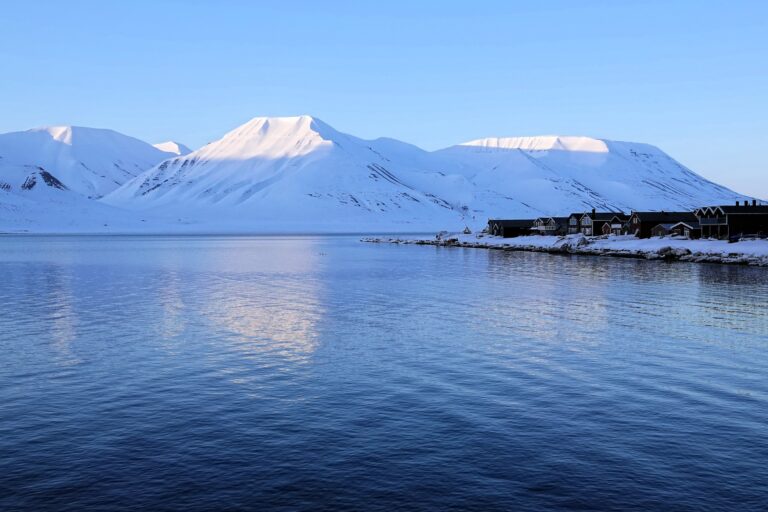
Just north of the town center, you walk past this row of old boat houses that have been converted into homes. Technically it’s not allowed to live permanently in them, for safety reasons.
There’s a shortage of accommodation in Longyearbyen, and the government has decided that the town will simply not be allowed to grow. So people stay where they can. And if you stay here, you have the best possible view of the sea.

Truth be told, Longyearbyen is not the prettiest of towns. It carries its many scars and left-over large pieces of metal junk from the coal mining era with pride.
Homes are generally sparsely decorated, often embellished mainly with reindeer antlers, seal skins, whale bones, and whatever curious items people have found lying around in nature.
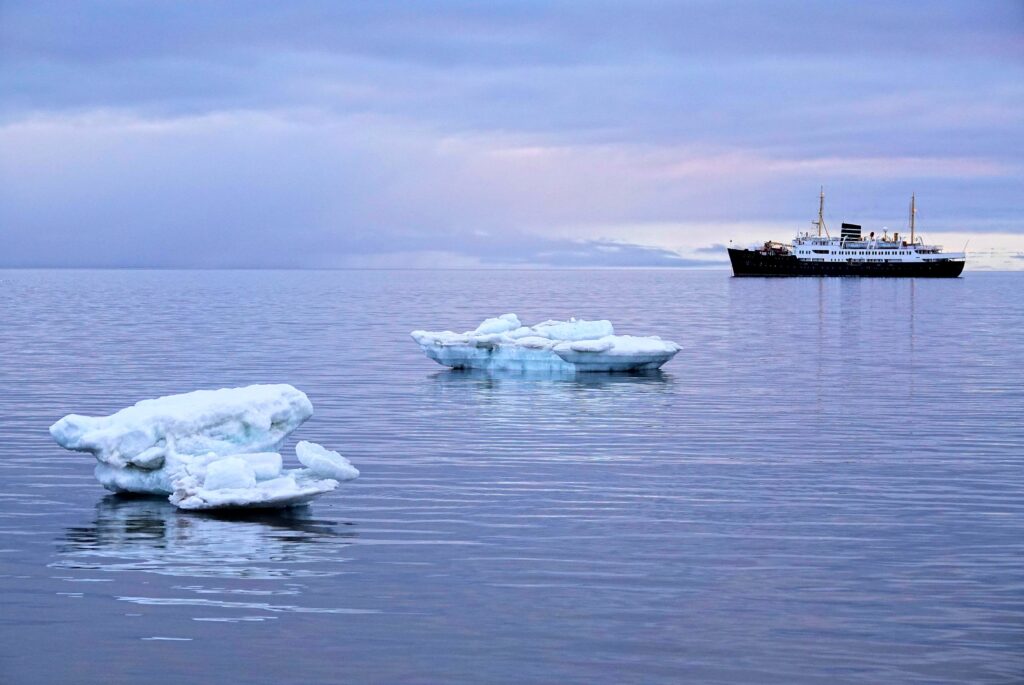
Fortunately, if we look away from the buildings, there is plenty of visual harmony to be found in Longyearbyen.
Like these small icebergs that form a nice trio together with MS Nordstjernen, a charming old ship that does summer tours of the Spitsbergen archipelago.

If you’re in Longyearbyen just after a full moon, make the most of the extra low tide you get down at the beach.
This will allow you to walk on dry land quite a bit out from what at other times is the coastline. The landscape around you will be mirrored by small ponds, often making for some really stunning views.
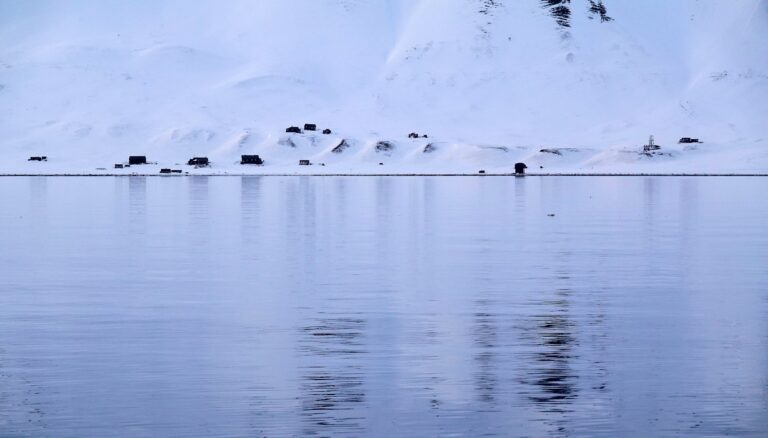
Across the fjord are the remains of Hiorthhamn, another old mining town.
There’s no commercial activity there today. The buildings were saved from decay by locals in Longyearbyen turning them into cabins. People have an urge to get away from the hustle and bustle of the city, to a place where they can calm down for the weekend in a wooden cabin without water and electricity, but with a good chance of a polar bear visit. Hiorthhamn is just the place for that.

Icebergs from glaciers in the area sometimes enter the fjord next to Longyearbyen and get stuck on the beach. Other “icebergs” are just pieces of ice that have broken away from the ice shelf covering the beach.
Either way, a large chunk of ice can through random melting take on any shape, and it’s fun to walk around and “see” different things in them. It’s a little bit like watching clouds.

Summer days in Longyearbyen are great for going out on the water in a kayak.
During winter, though, the kayaks are just stored on the beach, looking miserable and misplaced. Seeing them is a reminder that this place is not always wintery. It’s a comfort, especially to those who live here.

On every nice weather night during midnight sun season, a proper feel-good experience just before midnight is to walk down to the part of the beach that is closest to the town center. Usually a good crowd of people, a mix of locals and tourists, is gathered there to enjoy the view.
The locals can usually be recognized as the ones having a barbeque. The tourists generally take selfies instead. Everyone seems equally happy, though.
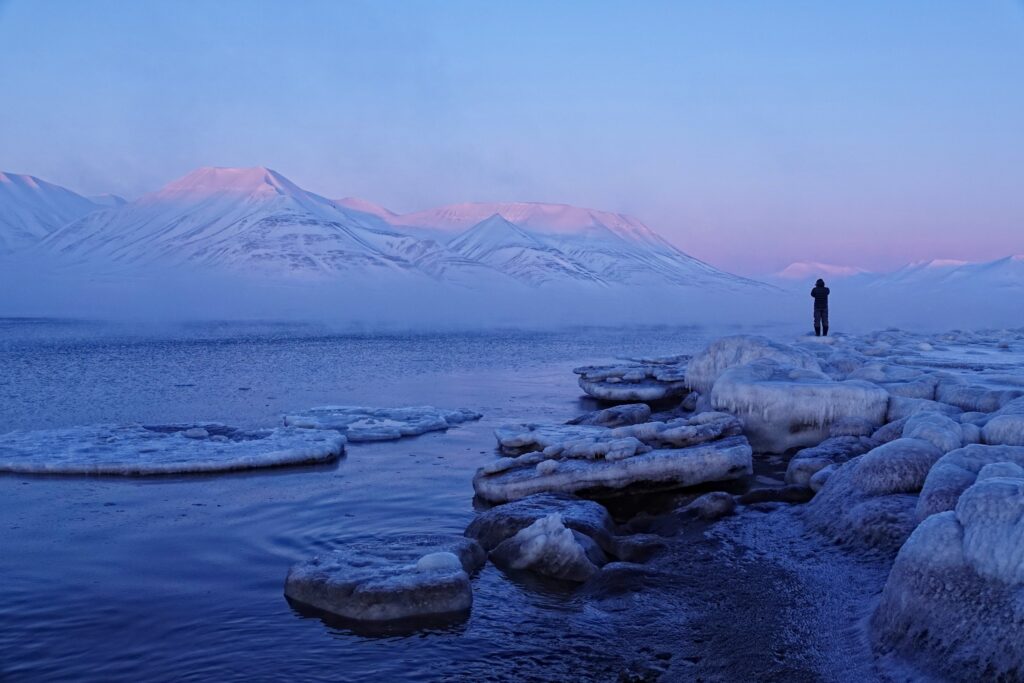
In rougher weather, or even on nice evenings that simply are too cold, you may be the only person on the beach.
Your gain, their loss.
Each type of weather comes with a separate set of qualities. Sometimes you have to search a little to uncover them, but even on the coldest day there is deep beauty to be found.
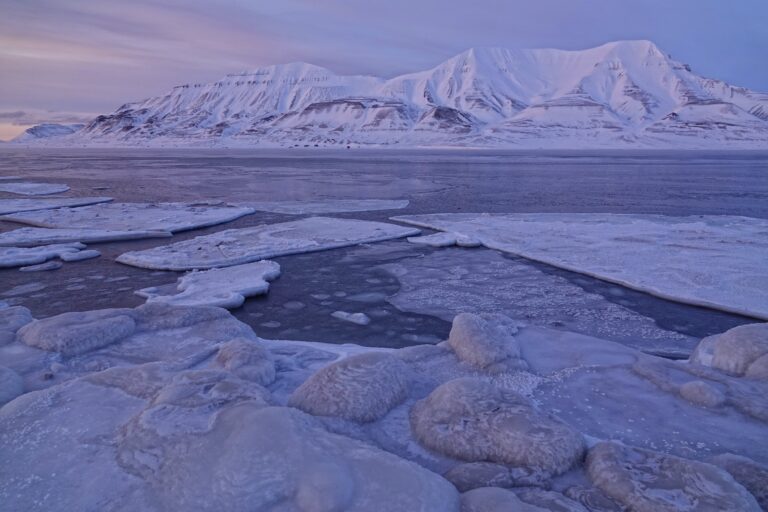
The sea in Adventfjorden has not frozen over properly for many years now. This photo shows about the most ice cover I have seen here.
To citizens of Longyearbyen this is good, as it means that the supply ship that arrives every two weeks is able to unload a new batch of food and other stuff throughout the year.
The mountains beyond the water are Adventtoppen to the left and Hiorthfjellet to the right. I can happily sit for hours and just watch them continuously change colors and shades as the evening passes.
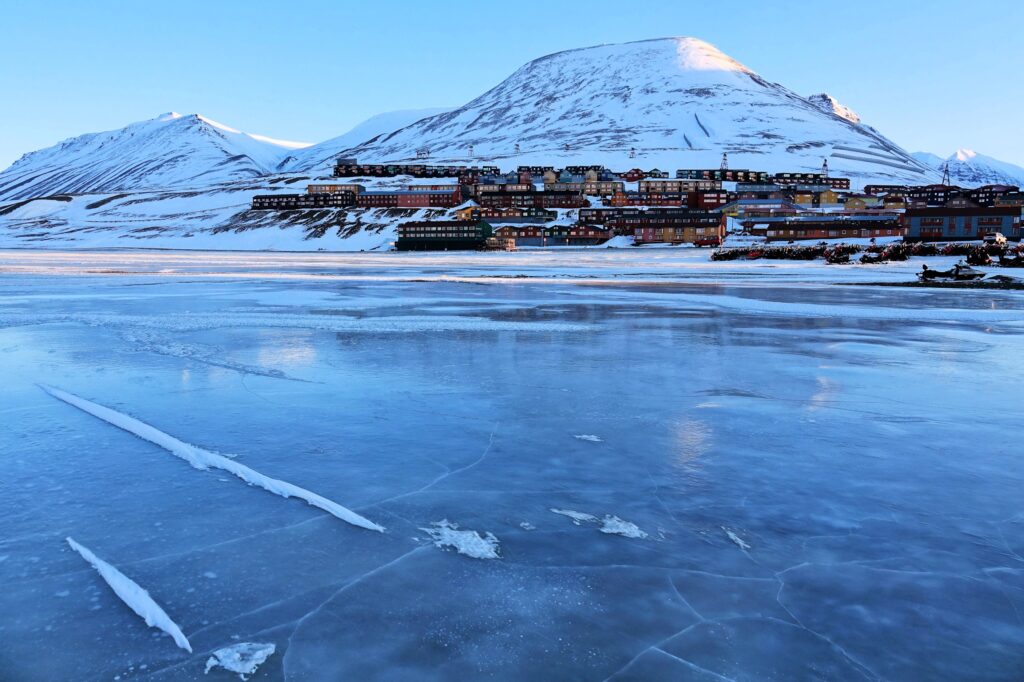
We have just about completed our walk. You are now looking at Gruvedalen, the part of Longyearbyen with the highest population density. Good reasons for living here are that almost every house has the view of the mountains you saw in the previous photo, and that most buildings here are relatively new and well insulated and therefore efficiently heated.
The ice in the foreground here is why you should study penguins and the way they walk.

At the east end of Longyearbyen, we reach the area where most snowmobile trips leave from. There are around 3,000 snowmobiles on this island. Yes, there are more snowmobiles than people here. If you have a driver’s license for car from pretty much wherever, mysteriously you are somehow qualified to drive a snowmobile on Svalbard!
You can book yourself onto many different snowmobile tours. They range from easy short trips near town, to a full day of riding all the way to the east coast and back, after which you will be thoroughly exhausted, no matter how experienced you are. I recommend that you start out on an easy trip, to find out if this is for you.

From the departure point for the snowmobile trips, you can look straight across the valley towards this deliciously curvy mountain, Operafjellet.
The tiny black dots on the ground are cabins. These are mighty peaks. They have the typical Svalbard look, with lots of ridges perfect for building up an avalanche that can go off at any time. Make sure you only go near them with someone who knows how to read snow, or you may end up under lots of it.
This, by the way, is how these mountains appear only when things are clearing up after a good and heavy blizzard. A day of two of heavy winds later, the mountain sides may lie dark and bare again.
I much prefer the white version.
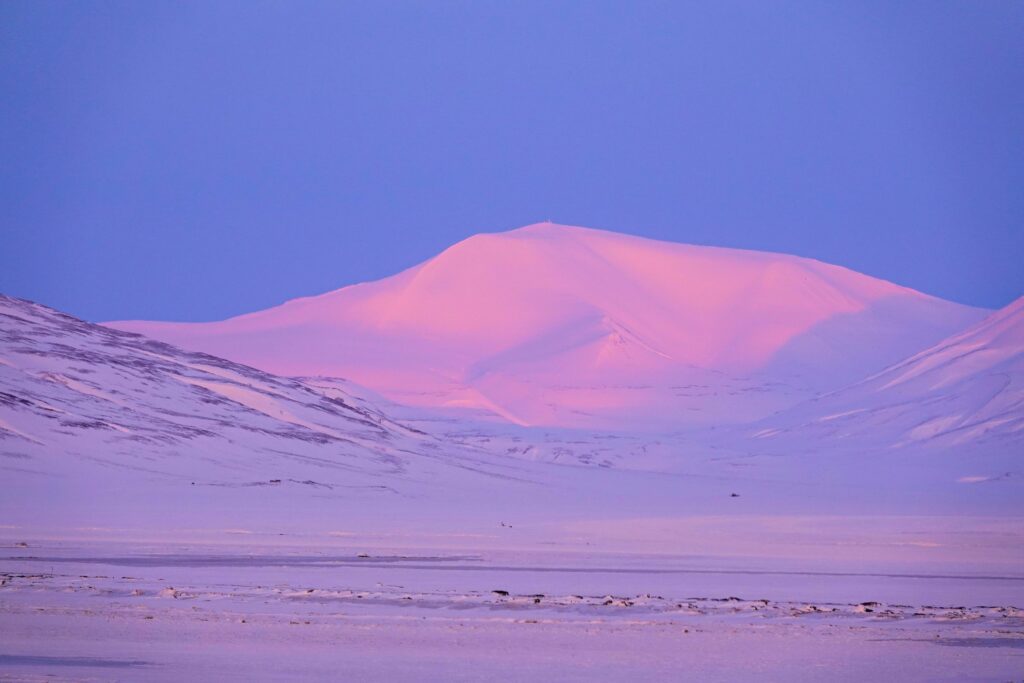
We have reached the end.
As you walk past the large dog yard and again find the sign that warns of polar bears, you can not walk further east. But you can look further east as much as you want, towards the lovely mountains of Adventdalen, sometimes wearing their sunset blush, lik here.
Let your eyes feast on this until you’re suitably happy. Now hike back to the town center and feast on food and drinks until it’s time to go to bed, never mind the lack of darkness outside. If it’s really late, I recommend visiting the relaxed restaurant Kroa, where they serve up filling pizzas until 1:30 in the morning every day.
I hope you have enjoyed this Arctic walk. If you have any questions about anything I have mentioned, feel free to ask them in the comments.
Happy trails!

Tips for Longyearbyen
Transportation
There is no need to rent a car in Longyearbyen. To get between the airport and town, there is always a bus you can catch, corresponding with every flight.
In town you will be fine just walking. If you really need to get somewhere fast, there is a taxi service.
Accommodation
There are no bad options, but there are some real differences between your options.
Prices vary quite a bit, so you may have to choose your place to sleep just based on that. It’s fine. You will be warm and comfortable wherever you stay, and if you are looking to meet other travelers, that’s pretty easy, too. Talk to people on your flight. Chances are you are staying for about the same number of days and doing many of the same things. Might as well get to know them right away. Stay at a place with a dormitory and shared kitchen if you want instant new friends.
To me, the main difference to consider is location. Longyearbyen is small and walkable, so anywhere is okay. But staying in Nybyen, the southern part of town, means you have an extra 20-30 minutes to walk each way to almost any useful or interesting spot. It’s not a problem if you book activities, as you will be picked up from your accommodation wherever you stay. But if you want to do “my” beach walk, it’s a much longer walk. If you want to buy groceries or check out the museums, it’s a small expedition in itself. Staying near the town center is arguably more convenient and will potentially mean you get more out of your stay.
Economical Choices
Gjestehuset 102
Plus: Good hostel with reasonable rates. Reasonably short walk to foodie and somewhat expensive restaurant Gruvelageret, which you usually need to book for in advance.
Minus: 2.5 kilometer walk to shops and most restaurants and cafes. Small risk of being evacuated because of potential danger of avalanches,especially during the month of April.
Coal Miners’ Cabins
Plus: Good value rooms. Has its own restaurant, which is fine.
Minus: A bit far away from most things you need, just like Gjestehuset 102, see above.
Haugen Pensjonat Svalbard
Plus: Only half as far away from the town center as the two options above.
Minus: Adequate, but basic standard. Maybe not the best place to come back home to after a long, cold day on a tour.
Mary-Ann’s Polarrigg
Plus: Fun place with peculiar decorations. Has its own somewhat pricey really good restaurant, Vinterhagen. Also access to shared kitchen.
Minus: A bit basic rooms, which is why the rates are so reasonable. So maybe it’s perfect for you.
Mid-Range Choices
There’s not that much to say about these. They’re basically all a good balance between price and what you get.
Really Nice Hotels
These are usually more expensive than the other options, and there’s a reason for it. They usually have really good restaurants in the hotel, but keep in mind that those places to eat are open to anyone, wherever they stay. Also look out for things like outdoor jacuzzis that are free to use for guests, saunas. They are all very conveniently located for anything, and have a pretty amazing breakfast included in the room price.
Funken Lodge
A really nice place, with probably the best hotel restaurant in town. Very foodie-friendly.
Svalbard Hotell – Lodge
More apartments than hotel rooms, really. Lots of amenities available, many in your room.
Radisson Blu Polar Hotel
International chain hotel with very much a touch of Svalbard. Excellent views, and technically the northern-most hotel in Longyearbyen.
3 Comments. Leave new
I just stumbled upon your blog from your NK pictures on Reddit and I love it! Thank you so much for sharing your experiences and photos with the world 🙂
All the best,
A fellow traveler from Poland.
Hello. Is it still safe/advisable to do this walk in winter? I don’t just mean polar bears, but all in all considering weather, daylight, the route/trail/roads, etc. We will be there on Feb 7 to 10.
BTW, would you know if there are tours going to Pyramiden on our dates?
Thanks in advance!
In early February I would say it’s perfectly fine to do this walk during the middle of the day. Between 10 and 15 you will have “civil twilight”, which means the sun does not rise, but it is not far below the horizon. You will see well enough for this to be a good walk. If you’re lucky and go a bit earlier or later , there can be traces of northern lights, too. Check forecast on nordlysvarsel.com for that, and hurry outside if you see a good chance of catching the lights.
Pyramiden is not offered by any serious tour operators in Longyearbyen, and the same with Barentsburg. This will continue to be the situation until Russian troops leave the occupied territories in Ukraine.